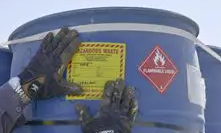When hazardous chemicals or materials are placed into a container, it becomes necessary to mark and label that container to make all employees, transporters, and regulators aware of its contents. All employees should use the same method to label the containers; industry standard handwritten labels are the most common. If you’re reusing a container, remove the old labels or black them out.
Discussion Points:
• Label containers when chemicals are placed in the container,
• Use industry standard labels,
• Stay compliant with EPA, RCRA, and state environmental agency requirements,
• Follow DOT regulations for labeling when shipping hazardous waste,
• All employees handling hazardous waste containers must be trained.
Discussion:
To stay compliant with the Environmental Protection Agency (EPA), the Resource Conservation and Recovery Act of 1976 (RCRA), and your state environmental agency requirements, place a label on a container when the chemical is placed inside it. The EPA specifies that any waste container equal to or less than 119 gallons must be labeled; the standard waste container is a 55-gallon drum. The EPA requires that a container used for hazardous chemicals be marked with the words “Hazardous Waste.” It must display the starting date for its accumulation along with information about its contents, such as toxic or corrosive, and the generator’s name,
address, and EPA ID#.
When the hazardous waste is ready to ship for disposal, the Department of Transportation (DOT) labeling requirements must be followed, which includes adding the Manifest Tracking Number; regulations for packaging waste found in 49 CFR Parts 172, 173, 178, and 179. The label markings must be in English, durable, visible, and not obscured or confused by other markings. It is recommended not to use “homemade” labels; instead, use common waste labels that follow “industry standards” for the format and information using the Non-Hazardous Waste, green and white, or Hazardous Waste, yellow and red standard labels.
Labels should never be placed on the bottom of the container or placed near any other markings. If there are multiple labels, they should be displayed next to each other with a six-inch space between them. The primary hazard label should be placed above and to the left of the subsidiary hazard label.
All employees handling hazardous waste containers must be trained and understand the information and markings displayed on the labels. Federal law prohibits improper disposal of chemicals and materials. A compliant waste labeling system is vital to avoid regulatory penalties and fines.
As always, be safe out there!


Recent Comments